The snow has finally stopped falling. The night sky has begun to clear. A deep, white blanket lies softly over the earth, smothering the harsh angles of hill- and mountainside, forest and stream, rolling smoothly across the landscape in a single frozen undulating wave. It is cold, bitterly so, even for Alaska. In the dark silence of the winter solstice, the cells of some trees that venture above the snow can hold together no longer and split open with a resounding crack! Above, scudding clouds pull back to the horizon and stars glisten in the liquid blackness.
It is now, say the Yup’ik, that the night sky of winter threatens to descend and steal whatever life the earth possesses.
But beneath the sheltering snow, under the insulating ice of streams and lakes, millions upon millions of hearts beat. Clear, fresh water swirls in and around gravel worn smooth from the unceasing erosion of thousands of years. Hidden among the gravel, no larger than a tadpole, safe from predators and bathed with the flowing water’s life-giving oxygen, lie young sockeye salmon.
Here in the southwest corner of Alaska known as Bristol Bay, in a region about the size of the state of Washington brimming with freshwater lakes and streams, exists one of earth’s grandest and most spectacular wildlife pagents—one whose numbers exceed the past great migrations of bison and passenger pigeons, and which, in the short history of humankind, has proven far more important. As their ancestors have done for countless millennia before them, these young salmon will grow and mature over the next few years, descend freshwater streams to the sea, travel over one thousand miles throughout the North Pacific Ocean, then return with remarkable timing and precision to ascend, spawn, and die in the waters of their birth.
Although the journey of salmon is a well-known phenomenon, what isn’t widely acknowledged is that Pacific salmon have disappeared from 40 percent of their original range, and their survival is at risk in another 27 percent. In Alaska’s Bristol Bay—home to the world’s greatest wild sockeye salmon population—they still occur in numbers almost beyond belief, both humbling and stirring human imagination. During the Pacific Northwest’s heyday of the 1800s, before dams, erosion, pollution, and overfishing destroyed its fishery, the bountiful Columbia River Basin produced about 16 million salmon each year. As recently as 1995, nearly four times that number—62 million salmon—returned to Bristol Bay. Stacked nose to tail, that many fish would stretch all the way around the earth at its equator. They would weigh more than one thousand blue whales.
How this corner of Alaska came to be home to the world’s greatest wild salmon fishery is the story of a unique freshwater landscape closely tied both to the sea and the land’s denizens—wildlife and people; a landscape whose continued existence depends upon a healthy and viable salmon fishery.
“The salmon is the sea’s silver messenger,” a Yup’ik woman once told me. “It says to all of us who live here: ‘Never forget who gives you life.’”
In a world where, as ecologist Aldo Leopold observed, we’re beginning to realize that everything is connected to everything else, the truth of these words seems so obvious. But the vast extent and complexity of this ancient belief of the Yup’ik and other Pacific Rim native peoples in the intimate relationship between ocean and land has only recently been confirmed by science. Their way of thinking, it turns out, couldn’t be more correct.
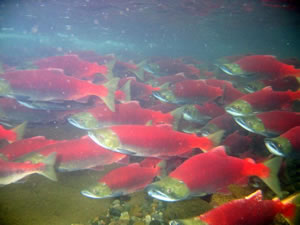 When salmon return to spawn and die, choking the shallow streams with their bruised and crimson bodies, they leave behind not only another generation, but a wealth of essential elements that suffuses and energizes a vast web of life, without which the salmon wouldn’t exist at all. Only recently have researchers discovered that the food webs of salmon-based ecosystems—algae, crustaceans, insects, other fish, birds, otters, even bears—contain nitrogen, phosphorus, carbon, and other organic elements which possess a unique isotopic ratio found only in marine environments. It seems a vast array of terrestrial life in these ecosystems is comprised mainly of oceanic material brought landward by salmon. Given how many plants and animals depend upon its existence, then, scientists term salmon a “keystone” species.
When salmon return to spawn and die, choking the shallow streams with their bruised and crimson bodies, they leave behind not only another generation, but a wealth of essential elements that suffuses and energizes a vast web of life, without which the salmon wouldn’t exist at all. Only recently have researchers discovered that the food webs of salmon-based ecosystems—algae, crustaceans, insects, other fish, birds, otters, even bears—contain nitrogen, phosphorus, carbon, and other organic elements which possess a unique isotopic ratio found only in marine environments. It seems a vast array of terrestrial life in these ecosystems is comprised mainly of oceanic material brought landward by salmon. Given how many plants and animals depend upon its existence, then, scientists term salmon a “keystone” species.
In top-of-the-food chain consumers, such as grizzlies and rainbow trout, as much as 80 percent of their bodies are derived from salmon. Even young salmon cannibalize dead adults. In spring the young fish move into lakes and begin to feed voraciously on plankton whose growth is largely dependent on the nutrients from decomposing salmon of the previous year. So great is this annual accumulation of oceanic nutrients—salmon in Bristol Bay watersheds deposit each year more than one thousand tons of nitrogen alone—that scientists studying core samples from lake and estuarine sediments have been able to reconstruct histories of salmon production dating back centuries. Also, land plants such as spruce, willow, and alder cycle the life-giving nutrients deposited in excretions from salmon-feasting bears, gulls, and ravens. In some cases, recycled nitrogen and phosphorus from salmon have been partly responsible for the luxurious vegetative growth found along high-altitude streams in Alaska. Not surprisingly, it wasn’t long ago that the Yup’ik—who, like other native people of southwest Alaska and throughout the Pacific Rim, consume annually several hundred pounds of salmon per family—were similarly constructed of this lustrous messenger from the sea.
How the first salmon found their way from salt to fresh water is a simple, if shadowy, tale. Some fifty million years ago, during the Eocene Epoch, when the earth was warmer and mammals were just starting their rise, the first salmon, called dawn salmon, appeared. Twenty million years later, salmon had evolved into a number of species, one of which, the saber-toothed salmon, was over ten feet long, weighed five hundred pounds, and possessed giant fangs. During the most recent whisper in geologic time, perhaps as little as two or three million years ago, during the Pliocene—before the continents of North and South America were connected by the Panama land bridge—oceanic fish were able to swim freely between the Atlantic and the Pacific. By the time the continental land bridge arose and separated the two oceans, a sleek, torpedo-shaped species had appeared in the Pacific, one not unlike today’s Atlantic salmon (Salmo salar). While the fossil record is sketchy and subject to varying interpretations, most scientists believe this ancient Salmo soon gave way to a fish closely resembling today’s rainbow trout (Oncorhynchus mykiss).
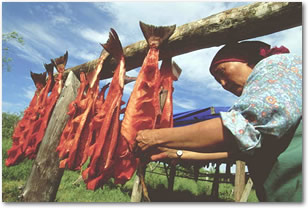 This ancestral trout-salmon appears to have taken up residence in brackish estuaries at the edge of the Sea of Japan. As ocean levels rose during the warm interglacial periods of the last ice age, streams and lakes near the sea were periodically inundated with salt water. It wasn’t long before trout-salmon learned to take advantage of both ocean and fresh water, ascending streams to spawn but spending the greater part of their life in the ocean. Like today’s seagoing rainbow trout (steelhead), this progenitor was capable of spawning more than once, and it soon spread to similar environments on both continents bordering the North Pacific. Given its wide geographic range and the differing environments, speciation occurred quickly, producing the present seven species of Pacific salmon and two species of trout—rainbow and cutthroat—that make up the genus Oncorhynchus (from Greek, describing the “beaked jaw” of spawning fish). So successful was this genus that it is now the dominant epipelagic fish across thousands of miles of ocean.
This ancestral trout-salmon appears to have taken up residence in brackish estuaries at the edge of the Sea of Japan. As ocean levels rose during the warm interglacial periods of the last ice age, streams and lakes near the sea were periodically inundated with salt water. It wasn’t long before trout-salmon learned to take advantage of both ocean and fresh water, ascending streams to spawn but spending the greater part of their life in the ocean. Like today’s seagoing rainbow trout (steelhead), this progenitor was capable of spawning more than once, and it soon spread to similar environments on both continents bordering the North Pacific. Given its wide geographic range and the differing environments, speciation occurred quickly, producing the present seven species of Pacific salmon and two species of trout—rainbow and cutthroat—that make up the genus Oncorhynchus (from Greek, describing the “beaked jaw” of spawning fish). So successful was this genus that it is now the dominant epipelagic fish across thousands of miles of ocean.
Of the seven species of Pacific salmon, two occur only in the Sea of Japan, in relatively small numbers and displaying some of the characteristics of rainbow trout. The other five species are believed to be of more recent origin, and are widely distributed throughout the Pacific Rim, arcing north from Japan across the Kamchatka Peninsula to Alaska, then down the British Columbian coast to California.
Those salmon most abundant—pink and chum—spawn primarily in tidal areas or the mouths of rivers and streams, and their young spend little time in fresh water. In the case of pinks, their lives are relatively short, only two years or so. The less numerous chinook and coho (also known as king and silver salmon) often spend at least a year in freshwater streams. Kings in particular grow large—often more than fifty pounds—and are longer-lived, typically as much as five or six years. The largest chinook ever caught was a 145-pounder, though it’s possible larger chinooks may be swimming the Pacific even now.
The salmon that shows the most diversity among its myriad populations, however, is the third-most abundant species worldwide, and far and away the most numerous and commercially valuable salmon in southwest Alaska: the red or sockeye salmon (Oncorhynchus nerka). The term sockeye is a corruption of sukkai, the name for the species used by the native people of southern British Columbia. Alaska’s Yup’ik call it sayak, but in western Alaska it’s also known as blueback or redfish, although these names were more common a century ago. After emerging from their gravel incubators, sockeyes typically spend one or two years in freshwater lakes, then migrate to the North Pacific, where they feed and grow for two or three years before returning to spawn.
Despite our human tendency to dwell on their differences, salmon species retain certain common characteristics. All are sleek, hydrodynamic fish, built for continuous cruising and quick bursts of speed rather than maneuvering. In salt water, before assuming spawning colors, they appear so similar that the untrained eye has difficulty telling them apart. But a salmon’s most astounding trait is the one that has given it such evolutionary success: anadromy—a word meaning “up-running,” but more specifically, possessing the ability to inhabit both marine and freshwater environments.
Why anadromy? What makes it a better survival strategy? After all, many fish in either salt water or fresh water have successfully evolved without mixing waters.
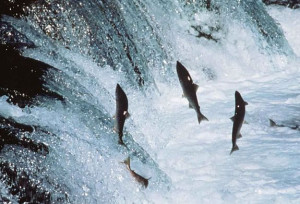 First, fresh water is safe, at least relatively so; the sea harbors far more predators, both in kind and number. Spawning salmon are for the most part unhampered by interference from other fish, and pea-sized eggs and young hatchlings find both adequate oxygen and refuge from predators in the uniform gravel of many streams and lake shores. Later, when young salmon move into nearby lakes and streams, they continue to grow, again largely free from the predation smaller fish face at sea. But once the young grow to minnow size, they face a crucial problem in fresh water: how to grow as much as possible before producing another generation. Fecundity is related to size; only big fish produce large numbers of eggs. And in fresh water there simply isn’t enough food, particularly in the cold lakes of northern latitudes, to allow a huge population of fish-like salmon to attain a large size (a landlocked version of sockeye salmon, called kokanee, is notably much smaller and less abundant than its seagoing cousin). Migration to the ocean, with its bountiful food supplies, solves this problem, resulting in maximal growth, which ultimately leads to maximal reproduction.
First, fresh water is safe, at least relatively so; the sea harbors far more predators, both in kind and number. Spawning salmon are for the most part unhampered by interference from other fish, and pea-sized eggs and young hatchlings find both adequate oxygen and refuge from predators in the uniform gravel of many streams and lake shores. Later, when young salmon move into nearby lakes and streams, they continue to grow, again largely free from the predation smaller fish face at sea. But once the young grow to minnow size, they face a crucial problem in fresh water: how to grow as much as possible before producing another generation. Fecundity is related to size; only big fish produce large numbers of eggs. And in fresh water there simply isn’t enough food, particularly in the cold lakes of northern latitudes, to allow a huge population of fish-like salmon to attain a large size (a landlocked version of sockeye salmon, called kokanee, is notably much smaller and less abundant than its seagoing cousin). Migration to the ocean, with its bountiful food supplies, solves this problem, resulting in maximal growth, which ultimately leads to maximal reproduction.
Another way that anadromous salmon stack the genetic cards in their favor is by faithfully returning to the waters of their birth. There’s only so much spawning gravel in a given watershed. If immense numbers of salmon were to return haphazardly, any single habitat might be over- or underutilized. Salmon solve this dilemma by homing precisely to the waters—sometimes even to the very rivulet or lake beach—where they were born. Thus each suitable freshwater habitat has its own resident spawners. In Alaska alone, biologists have identified some ten thousand spawning populations of commercial importance, but there are probably many more. Sockeye, in particular, have evolved into myriad races or subpopulations, often marked by distinct traits such as color, size, flesh texture, and even taste, making them readily discernible to those who catch or study them.
Returning to the same birth waters offers yet another advantage—it separates breeding stock so that although salmon may later commingle in the ocean, they experience early differences in temperature, food type and abundance, predators, and other stimuli that are unique to their specific waters. This critical information then passes or “flows” genetically from one generation to the next, reflecting the unique environment of each breeding population. At the same time, it provides an immensely diverse gene pool for the species at large.
For salmon, as for all life, biodiversity is the best defense against a constantly changing universe.
This diverseness spreads throughout the species by the 1 or 2 percent of each population that isn’t faithful to its home waters. These fish stray throughout the watershed, ensuring that genetic diversity is spread far and wide throughout the species. Straying also helps ensure spawning habitat will never be entirely lost should some disaster, such as a temporary landslide or a summer drought, block homing salmon from ascending a stream. The original stream population may die out, but in years to come, after the stream returns to normal flow, stray spawners may some day recolonize its waters.
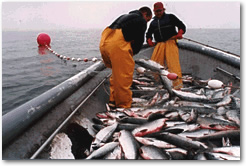 Thus salmon have arrived at numerous ways to make anadromy work exceedingly well. Caution is the word here, though, for when assigning cause and effect in evolution, one treads a minefield. Many of the specializations to which we so eagerly assign adaptive significance are buried deeply in the past. The present can be described, analyzed, and to some extent, understood. But the past, which always controls the future in evolution, remains forever shrouded. In the case of anadromy, we may understand its advantages but we can only speculate as to the reasons why it evolved for salmon over other survival strategies.
Thus salmon have arrived at numerous ways to make anadromy work exceedingly well. Caution is the word here, though, for when assigning cause and effect in evolution, one treads a minefield. Many of the specializations to which we so eagerly assign adaptive significance are buried deeply in the past. The present can be described, analyzed, and to some extent, understood. But the past, which always controls the future in evolution, remains forever shrouded. In the case of anadromy, we may understand its advantages but we can only speculate as to the reasons why it evolved for salmon over other survival strategies.
One thing seems certain. As an evolutionary path, anadromy works best for salmon as a high numbers game, meaning that vast spawning populations are required to succeed. There appears to be some critical mass—what scientists unimaginatively term a “minimal breeding unit”—needed for continued reproductive success. In certain streams or lakes, if salmon fall below this number, through overfishing or habitat degradation, they may find themselves unable to successfully recover. No one knows exactly why. Scientists theorize that a small number of salmon may be simply insufficient to create an environment that stimulates spawning behavior.
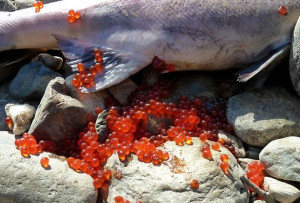
Packed within each egg is an organism that gives rise to a rich and diverse ecosystem of immense abundance.
With mass spawning also comes mass death for Pacific salmon. Other anadromous salmonids—Atlantic salmon and steelhead—often manage to survive the great physical toll of spawning, and return to the sea. The reason again seems to lie in numbers. Neither Atlantic salmon nor steelhead occur in such teeming populations sufficient to exhaust a large proportion of seasonally available food in both marine and freshwater environments. To maintain an evolutionary success built upon immense numbers—given abundant but limited food resources and the natural seasonal cycles that control them—any solution other than death seems inconceivable. If adult Pacific salmon were suddenly to survive spawning and return to the ocean, their great populations would quickly dwindle.
Anadromy isn’t the only mystery about salmon. Consider the sockeye and its remarkable journey from egg to death. Even though it’s the most-studied salmon species and much is known about its life cycle, huge gaps remain.
Each sockeye begins as a single, oil-filled capsule. Inside are two cells, one each from its father and its mother, a virtually invisible spot of tightly coiled molecular enzymes. These enzymes contain an intricate computer-like design that not only determines the body shape and function of an adult salmon—when to eat, swim, spawn, and die—but also allows the fish to record and later recognize the odor of its birth stream, change its physiology to accommodate both fresh and salt water, create an internal map of the North Pacific and a clock that is accurate nearly to the hour, and finally, determine its location using stars, sun, and moon, and the earth’s magnetic fields, to travel a distance of 1,300 miles and arrive back at the stream of its origin within a week, sometimes even a day, of its departure four or five years earlier.
Science has scarcely a clue how these mechanisms work.
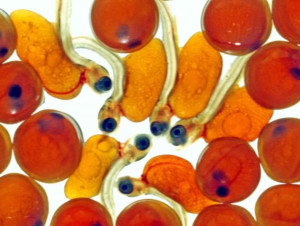 It’s autumn and the embryo inside the egg lies shallowly buried in gravel, secluded in its orange, lipid-rich world. Oxygenated water flows constantly over its surface. As fall turns to winter, two black eyes appear, followed by a tiny backbone, as the egg yolk is slowly absorbed. Scientists term this stage of salmon life an alevin, although once a Bristol Bay fisherman more aptly called it “two eyeballs on a thread.”
It’s autumn and the embryo inside the egg lies shallowly buried in gravel, secluded in its orange, lipid-rich world. Oxygenated water flows constantly over its surface. As fall turns to winter, two black eyes appear, followed by a tiny backbone, as the egg yolk is slowly absorbed. Scientists term this stage of salmon life an alevin, although once a Bristol Bay fisherman more aptly called it “two eyeballs on a thread.”
By late winter or early spring, the yolk is fully consumed and the young salmon minnow—now called a fry—pushes through the gravel to the surface. It gulps air, filling its swim bladder to gain buoyancy, and, joined by thousands of other fry, floats downstream to the lake that will serve as its home for the next year or two. Sockeye are unique in utilizing a lake environment during the fry stage; other salmon fry, like coho and chinook, usually inhabit streams. Its numerous lakes are in fact what make the Bristol Bay region such an important sockeye nursery. Nowhere else in Alaska do lakes occur in such size and number, most at low elevations and short distances from tidewater.
Precisely how long sockeye fry remain in the lakes depends largely on their size. If summers are warm and conditions optimal, they grow quickly and stay in the lake for only one year. If water temperatures are cool and food is scarce in summer, though, they may spend up to two years in fresh water before heading out to sea. Fry school together, first feeding close to the lake’s edge on midge larvae and other small aquatic insects, then moving off into deeper water to feed on summer and fall blooms of lake zooplankton as they rise in daylight and sink at night. Here fry compete with other fish—mostly sticklebacks, pygmy whitefish, small char, and trout—for the same food. In turn, some fry are eaten by larger trout and char. Bristol Bay photographer Greg Syverson, clad in a wet suit with video camera in hand, has captured char, mouths agape, as they make slashing, sharklike attacks through schools of young sockeye.
In some years, as many as eight out of every ten fry fall prey to predators. Still, enough survive to lose their dark, juvenile stripes, or parr marks, and grow into two-inch smolt, the seagoing stage of salmon. Soon after the spring breakup of lake ice, smolt school at the outlet, and within a few days flush downriver to the sea. In Bristol Bay’s Kvichak (pronounced “kwee-jack”) River—the outlet of Lake Iliamna, Alaska’s largest lake and home of the world’s single-greatest sockeye salmon run—as many as sixty million smolt descend the river each day, usually during the hours of dimmest light, between 11 P.M. and 3 A.M. Standing in the Kvichak during the first few days of June, you can feel the young swimmers brushing against your waders as they make their break for salt water. Occasionally, the surface roils as huge trout and char boldly charge into the passing feast.
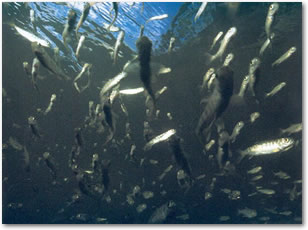
As many as sixty million smolt descend the Kvichak river each day, usually during the hours of dimmest light, between 11 P.M. and 3 A.M.
As smolt prepare to cross the invisible barrier from fresh to salt water, a huge physiological change takes place. They shed their olive, freshwater color and take on a bright silvery sheen due to increased production of a light-reflecting crystal called guanin, found in many oceanic fish swimming near the surface. While in fresh water, young fish constantly excrete excess water through their kidneys and take up salt ions through their gills in order to maintain a proper water and electrolyte balance. Now in the sea, with a salt content nearly three times that of salmon blood, the relationship reverses: salmon must now take up water from the ocean and actively excrete excess salts, a process that occurs in special cells found in the gills. This acclimation from fresh to salt water takes a while, and in early summer young smolt can sometimes be found in great numbers at the mouths of rivers and estuaries where the saline content of the water is lower than that of deep ocean. It’s also a dangerous time. Smolt can have difficulty adjusting to ocean temperatures; if the sea is unusually warm or cold, many simply fail to survive.
Predation usually increases as well. Sea birds—mostly gulls and arctic terns—swoop down on unsuspecting smolt, the birds’ crackling and throaty calls summoning others to the feast. Pods of beluga whales, with their white, plump bodies ghosting beneath the surface, also take their toll. Eagerly feeding on both smolt and adult salmon, these fourteen-foot behemoths have been observed as far upstream as Igiugig, a small Yup’ik village some thirty miles up the Kvichak River, at the mouth of Lake Iliamna. At times, belugas become prey themselves. In spring 1989, at the mouth of the Naknek River, a dozen orca whales lived up to their nickname, “wolves of the sea,” and attacked some fifty belugas gathered there to feed on descending smolt. As several awestruck fishermen watched, a massive, thirty-foot bull orca flipped the smaller belugas out of the water and up onto the beach. One observer described the attack as “a feeding frenzy with the water just boiling.”
Sockeye smolt soon move offshore to begin several years of ocean cruising, taking them over a thousand miles through the North Pacific. Due to diverse circulation patterns and the upwelling of nutrient-rich waters from the continental shelf, Alaska’s waters are among the most productive in the world. Here salmon follow major ocean currents that circulate mostly in a counterclockwise direction, swimming anywhere from ten to thirty miles per day, generally staying within thirty feet or less of the surface. In cool winters, they dip down to just above the fortieth parallel, the latitude of both Japan and northern California. In warm winters, they enter the Bering Sea north of the Aleutian Islands. As they roam, they mix with sockeye from Asian rivers, tens of millions of salmon participating in a great circuitous voyage only slightly smaller than the continental United States. Wherever they travel, they constantly feed on the prolific marine life—mostly squid, krill, copepods, amphipods, and juvenile fish—which in turn feast on the rich phytoplankton blooms that thrive on nutrient upwellings found in this turbulent area of the Pacific. Salmon feed on large zooplankton at night, while during the day crab larvae and small fish serve as the main entrees. Zooplankton in particular abound in carotenoid pigment, giving sockeyes their rich muscle color. No one knows why this common pigment—also found in carrots, egg yolks, and oranges, and related to vitamin A—is so pervasive in both phytoplankton and zooplankton, or what function it has in either these organisms or salmon. Nonetheless, by the time a sockeye reaches maturity, usually during its second or third year at sea, it commonly weighs between 4.5 and 6.5 pounds.
 Now the final and most astounding part of the journey begins. Using what appears to be a precise navigational system, mature sockeye forsake the sea and begin the journey back to their natal waters. Their timing could scarcely be more accurate. After ranging as far as Japan or Russia, as many as 80 percent of returning Bristol Bay sockeye reach their home saltwater estuary within a two-week period, usually peaking during the first week of July. They can’t afford to be too early. Spring upwelling along the Aleutian chain creates a high-saline, low-temperature water layer in the island passes, which blocks salmon migration. The barrier disappears in June and July, due to changing wind, tide, and current patterns, which push more-favorable water northward through the passes, allowing migrant fish to enter the bay.
Now the final and most astounding part of the journey begins. Using what appears to be a precise navigational system, mature sockeye forsake the sea and begin the journey back to their natal waters. Their timing could scarcely be more accurate. After ranging as far as Japan or Russia, as many as 80 percent of returning Bristol Bay sockeye reach their home saltwater estuary within a two-week period, usually peaking during the first week of July. They can’t afford to be too early. Spring upwelling along the Aleutian chain creates a high-saline, low-temperature water layer in the island passes, which blocks salmon migration. The barrier disappears in June and July, due to changing wind, tide, and current patterns, which push more-favorable water northward through the passes, allowing migrant fish to enter the bay.
Nor can they afford to be too late. Their arrival determines when they spawn, and spawning in turn determines when eggs hatch into young salmon the following year—critical since it must occur simultaneously with each particular lake’s springtime zooplankton bloom. Miscalculate this event by a week or two, and an entire generation’s young may starve.
How salmon actually perform this masterful feat remains one of the great mysteries of fishery science. But as any mariner knows, if you’re going to find your way across a featureless waterscape, it’s imperative to know at least one fixed location (north) and have some idea where you are in relation to that point. In order to arrive on time, you must also possess a timepiece. Thus the tools required are map, compass, and clock.
The latter two are relatively easy. Many animals—cicadas, monarch butterflies, gray whales, migratory birds—keep track of time with an endogenous calendar based on photoperiodism, a process scientists have long known as circadian rhythm: these animals’ internal biological clock keeps track of the time of year and the year itself. For a compass, many migratory animals, including salmon, use the sun and the stars. But when scientists looked at the often cloudy North Pacific, they realized that salmon must possess yet another method of determining geographic north. Recently they discovered magnetite, a kind of organic magnet inside the peanut-sized brain of salmon that may provide a kind of backup system when celestial objects aren’t visible. That leaves the map. For a map to be truly useful, it requires the use of a bicoordinate system: you have to know your position both east-west and north-south in order to determine precise location. Researchers surmise that salmon solve this dilemma by detecting magnetic declination, i.e., the tendency of the earth’s magnetic field to bend in an east-west direction, particularly near the poles. Keeping one eye on their internal clock and another on geographic north, determined from the sun, stars, or magnetite, salmon appear to reckon their position by using the earth’s magnetic grid.
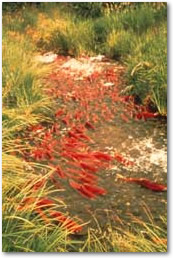 And that’s not all. Once migrating salmon find their way back to their natal estuary, another homing sense takes over: smell. Scientists discovered that salmon follow their noses in a classic experiment performed by Arthur Hasler at the University of Wisconsin in the mid-1970s. When Hasler plugged the nostrils of migrating salmon, they quickly lost their way. Further experiments indicated that each stream contains its own unique blend of chemical odors, which is imprinted on young salmon before they go to sea. Tests show that they may detect by smell as little as one part per trillion—the equivalent of a single drop of their home water in 500,000 barrels of river water made up of all the watershed’s tributaries. Until recently, scientists believed the brain to be the seat of these olfactory powers, but now it appears that sensory neurons in the nose itself are at least partly responsible. Regardless, once they reenter fresh water, salmon become aquatic bird dogs, relentlessly following the familiar scent home.
And that’s not all. Once migrating salmon find their way back to their natal estuary, another homing sense takes over: smell. Scientists discovered that salmon follow their noses in a classic experiment performed by Arthur Hasler at the University of Wisconsin in the mid-1970s. When Hasler plugged the nostrils of migrating salmon, they quickly lost their way. Further experiments indicated that each stream contains its own unique blend of chemical odors, which is imprinted on young salmon before they go to sea. Tests show that they may detect by smell as little as one part per trillion—the equivalent of a single drop of their home water in 500,000 barrels of river water made up of all the watershed’s tributaries. Until recently, scientists believed the brain to be the seat of these olfactory powers, but now it appears that sensory neurons in the nose itself are at least partly responsible. Regardless, once they reenter fresh water, salmon become aquatic bird dogs, relentlessly following the familiar scent home.
Since we humans confine ourselves mostly to land, now begins the part of the journey that we know and admire best: the tireless struggle against the current, all for the single purpose of a few moments of lust followed by inevitable death. The vision of individual salmon leaping huge waterfalls and ascending thousand-mile-long rivers is a false one for Bristol Bay. Waterfalls or steep rapids exist on some streams but they’re usually small, and most of the region’s drainages are relatively short and close to tidewater. Although exceptions exist, few Bristol Bay sockeye travel upstream more than one hundred miles, and many quite a bit less. Now the final and most astounding part of the journey begins. Using what appears to be a precise navigational system, mature sockeye forsake the sea and begin the journey back to their natal waters. Their timing could scarcely be more accurate. After ranging as far as Japan or Russia, as many as 80 percent of returning Bristol Bay sockeye reach their home saltwater estuary within a two-week period, usually peaking during the first week of July. They can’t afford to be too early. Spring upwelling along the Aleutian chain creates a high-saline, low-temperature water layer in the island passes, which blocks salmon migration. The barrier disappears in June and July, due to changing wind, tide, and current patterns, which push more-favorable water northward through the passes, allowing migrant fish to enter the bay.
Nor can they afford to be too late. Their arrival determines when they spawn, and spawning in turn determines when eggs hatch into young salmon the following year—critical since it must occur simultaneously with each particular lake’s springtime zooplankton bloom. Miscalculate this event by a week or two, and an entire generation’s young may starve.
How salmon actually perform this masterful feat remains one of the great mysteries of fishery science. But as any mariner knows, if you’re going to find your way across a featureless waterscape, it’s imperative to know at least one fixed location (north) and have some idea where you are in relation to that point. In order to arrive on time, you must also possess a timepiece. Thus the tools required are map, compass, and clock.
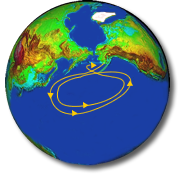
After ranging as far as Japan or Russia, as many as 80 percent of returning Bristol Bay sockeye reach their home saltwater estuary within a two-week period, usually peaking during the first week of July.
The latter two are relatively easy. Many animals—cicadas, monarch butterflies, gray whales, migratory birds—keep track of time with an endogenous calendar based on photoperiodism, a process scientists have long known as circadian rhythm: these animals’ internal biological clock keeps track of the time of year and the year itself. For a compass, many migratory animals, including salmon, use the sun and the stars. But when scientists looked at the often cloudy North Pacific, they realized that salmon must possess yet another method of determining geographic north. Recently they discovered magnetite, a kind of organic magnet inside the peanut-sized brain of salmon that may provide a kind of backup system when celestial objects aren’t visible. That leaves the map. For a map to be truly useful, it requires the use of a bicoordinate system: you have to know your position both east-west and north-south in order to determine precise location. Researchers surmise that salmon solve this dilemma by detecting magnetic declination, i.e., the tendency of the earth’s magnetic field to bend in an east-west direction, particularly near the poles. Keeping one eye on their internal clock and another on geographic north, determined from the sun, stars, or magnetite, salmon appear to reckon their position by using the earth’s magnetic grid.
And that’s not all. Once migrating salmon find their way back to their natal estuary, another homing sense takes over: smell. Scientists discovered that salmon follow their noses in a classic experiment performed by Arthur Hasler at the University of Wisconsin in the mid-1970s. When Hasler plugged the nostrils of migrating salmon, they quickly lost their way. Further experiments indicated that each stream contains its own unique blend of chemical odors, which is imprinted on young salmon before they go to sea. Tests show that they may detect by smell as little as one part per trillion—the equivalent of a single drop of their home water in 500,000 barrels of river water made up of all the watershed’s tributaries. Until recently, scientists believed the brain to be the seat of these olfactory powers, but now it appears that sensory neurons in the nose itself are at least partly responsible. Regardless, once they reenter fresh water, salmon become aquatic bird dogs, relentlessly following the familiar scent home.
Since we humans confine ourselves mostly to land, now begins the part of the journey that we know and admire best: the tireless struggle against the current, all for the single purpose of a few moments of lust followed by inevitable death. The vision of individual salmon leaping huge waterfalls and ascending thousand-mile-long rivers is a false one for Bristol Bay. Waterfalls or steep rapids exist on some streams but they’re usually small, and most of the region’s drainages are relatively short and close to tidewater. Although exceptions exist, few Bristol Bay sockeye travel upstream more than one hundred miles, and many quite a bit less.
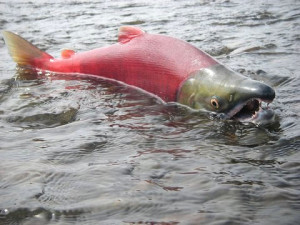 Late June and early July is the time to see the bay’s lower rivers choked with returning fish. One day they’re empty; the next, overflowing with salmon. Sometimes the only indication the fish are coming are the brown bears impatiently pounding the shoreline, occasionally halting to peer into the deep pools for telltale shadows. The fish travel in pods of tens, hundreds, thousands, crowding along the stream edge where currents are slowest, often moving at night, typically covering twenty but sometimes as much as sixty miles a day, resting in eddies or lakes for several days along the way. Before leaving salt water, they cease feeding and depend instead upon stored body fat and oils. Within days of entering fresh water, their color slowly begins to change from bright metallic silver to blue, then to green-gray along their backs, with sides still bright but tinged a pinkish hue. One or two months later, when most sockeye have reached their spawning grounds, a startling transformation has taken place. The flanks of the fish are now bright crimson, their heads the color of a kosher dill pickle. Typically the skin thickens, scales diminish, and the stomach shrinks. Males develop a darkly arched jaw, with a distinct hook or kype. Needle-sharp teeth protrude from black gums, and a fleshy hump forms along the dorsal fin. Females appear slightly less daunting, lacking the exaggerated hump and arched jaw, but they too display a set of mandibular meathooks reminiscent of their ancient saber-toothed cousins.
Late June and early July is the time to see the bay’s lower rivers choked with returning fish. One day they’re empty; the next, overflowing with salmon. Sometimes the only indication the fish are coming are the brown bears impatiently pounding the shoreline, occasionally halting to peer into the deep pools for telltale shadows. The fish travel in pods of tens, hundreds, thousands, crowding along the stream edge where currents are slowest, often moving at night, typically covering twenty but sometimes as much as sixty miles a day, resting in eddies or lakes for several days along the way. Before leaving salt water, they cease feeding and depend instead upon stored body fat and oils. Within days of entering fresh water, their color slowly begins to change from bright metallic silver to blue, then to green-gray along their backs, with sides still bright but tinged a pinkish hue. One or two months later, when most sockeye have reached their spawning grounds, a startling transformation has taken place. The flanks of the fish are now bright crimson, their heads the color of a kosher dill pickle. Typically the skin thickens, scales diminish, and the stomach shrinks. Males develop a darkly arched jaw, with a distinct hook or kype. Needle-sharp teeth protrude from black gums, and a fleshy hump forms along the dorsal fin. Females appear slightly less daunting, lacking the exaggerated hump and arched jaw, but they too display a set of mandibular meathooks reminiscent of their ancient saber-toothed cousins.
Dressed in regal attire, male and female begin their final pas de deux . The female selects a portion of the stream or shallow lake shore that consists of small pebbles or gravel and possesses a steady current of life-giving oxygen. With her side to the bottom, she flexes her tail or caudal fin in short violent bursts to dislodge gravel and silt. With brief rests, she repeats this procedure over and over until a hollowed-out depression, called a redd, forms on the stream bottom. Nest building attracts males, whom she chases away until she is satisfied she has found a suitable mate. The mating itself takes place just upstream of the redd. The male swims alongside the female, their bodies nearly touching. Suddenly they begin orgasmic quivering, the male arches over the female, their jaws gape wide, and their tails vibrate violently for several seconds. A burst of red-orange colored eggs—five hundred to one thousand—and milky sperm are released simultaneously. Coated with sticky milt, the eggs quickly sink to the bottom of the redd. The fish separate and the female immediately swims to the top of the nest and begins loosening gravel, which soon blankets the fertilized eggs. The female usually repeats this spawning act several times over the next few days, with the same male or another, until all of her eggs are released.
Of the approximately four thousand eggs she carries, an average of four hundred fry will reach the lake, thirty-two smolt will make it to sea, six adults will return to face the gill nets of Bristol Bay fishermen, and two or three salmon will survive the trip home to the waters of their birth.
 Spawned-out fish may live for several days or weeks, but soon their crimson bodies take on a dark, purplish hue, like a deep mortal bruise. Then they quite literally begin to fall apart—fins break off, eyeballs fall out, huge chunks of rotting flesh pull away from fungus-swathed bodies until it’s impossible to see the resemblance to the sleek, graceful swimmers of only weeks before. Exhausted, having lost nearly half their body weight and nearly 90 percent of their reserve fat since entering fresh water, and no longer able to face upstream, death finally brings their odyssey to an end.
Spawned-out fish may live for several days or weeks, but soon their crimson bodies take on a dark, purplish hue, like a deep mortal bruise. Then they quite literally begin to fall apart—fins break off, eyeballs fall out, huge chunks of rotting flesh pull away from fungus-swathed bodies until it’s impossible to see the resemblance to the sleek, graceful swimmers of only weeks before. Exhausted, having lost nearly half their body weight and nearly 90 percent of their reserve fat since entering fresh water, and no longer able to face upstream, death finally brings their odyssey to an end.
All along the stream or lakeside, in pools and back eddies, on exposed gravel bars and in shallow riffles, the bodies of dead and putrefying salmon flood the air with a choking, nauseating odor. As days pass, the loathsome stench changes to one that is salty, pungent, and smells, not surprisingly, like the ocean. Eventually the current sweeps the carcasses down into the lake below. There they sink and decompose, providing sustenance the following spring for the huge blooms of plankton that will begin the cycle anew.
Soon days grow shorter, cooler, and the surrounding tundra flames bright yellow, orange and red. Overhead, thousands upon thousands of migrating geese, ducks, brant, and swans wing southward on their long journey down the Pacific flyway. Snow begins to fall. Ceaseless Arctic storms, blowing up out of the gray and restless North Pacific, pummel the frozen land. Ice first appears along the shoreline and then creeps relentlessly over lakes and streams.
Beneath the ice, buried safely in gravel and bathed in oxygen-rich water, millions of hearts beat patiently, awaiting their chance to become silver messengers from the sea.


Leave a Reply
You must be logged in to post a comment.